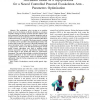Free Online Productivity Tools
i2Speak
i2Symbol
i2OCR
iTex2Img
iWeb2Print
iWeb2Shot
i2Type
iPdf2Split
iPdf2Merge
i2Bopomofo
i2Arabic
i2Style
i2Image
i2PDF
iLatex2Rtf
Sci2ools
ICRA
2005
IEEE
2005
IEEE
Hill-Based Model as a Myoprocessor for a Neural Controlled Powered Exoskeleton Arm - Parameters Optimization
— The exoskeleton robot, serving as an assistive device worn by the human (orthotic), functions as a humanamplifier. Setting the human machine interface (HMI) at the neuro-muscular level may lead to seamless integration and an intuitive control of the exoskeleton arm as a natural extension of the human body. At the core of the exoskeleton HMI there is a myoprocessor. It is a model of the human muscle, running in real-time and in parallel to the physiological muscle, that predicts joint torque as a function of the joint kinematics and neural activation levels. The study is focused on developing a myoprocessor based on the Hill phenomenological muscle model. Genetic algorithms were used to optimize model internal parameters using an experimental database that provides inputs to the model and allows for performance assessment. The results indicate high correlation between joint moment predictions of the model and the measured data. Consequently, the myoprocessor seems an adequate model...
| Added | 25 Jun 2010 |
| Updated | 25 Jun 2010 |
| Type | Conference |
| Year | 2005 |
| Where | ICRA |
| Authors | Ettore Cavallaro, Jacob Rosen, Joel C. Perry, Stephan Burns, Blake Hannaford |
Comments (0)

